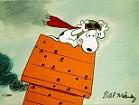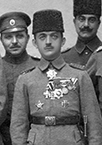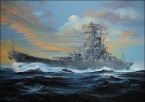castor troy
Posts: 14330
Joined: 8/23/2004
From: Austria
Status: offline

|
just for the sake of getting a funny explanation, two engagements from my latest PBEM turn. First engagement, the Oscars had the dive exclusively, only at the very end the dive ended. Result of today´s sending in 190 Allied fighters vs 45 Japanse were 25 Allied shot down A2A with another 11 lost to ops (write offs or crashes) for taking down 3 Tojos on escort. The 20 Tojos on escort managed for a repeated time to keep 100+ Allied fighters from even reaching the bombers. Now the nice thing (if you can find one as the Allied) was the second engagement saw the Allied having the dive which at least meant they wouldn´t be shred by diving Tojos. 5 Tojos were shot down by Lightnings at another target. All pilots are skill 70 as usual. 190 Allied fighters vs 45 Japanese, 36 vs 2 kill rate. Thank god the Tojos were on escort and not on sweep at 38000ft without the bombers. And thank god the Oscars ran out of ammo at some point.
Now with all the hurrey about realism and "I´ve been shot at, you are a plum" what´s the explanation for 25 Oscars taking on nearly 190 Allied fighters, taking down more than 20 of them for no loss. The only thing I could make out was the 38750ft they were coming in to dive and dive and dive and dive on every single Allied squadron that showed up one after another. Where I can employ fighters being able to fly higher, I can easily achieve air superiority, unfortunetely, in Burma the Japanese still are unbeatable due to the fact that Oscars and Tojos can fly higher than anything I could field. And no, having my fighters at 10000ft would not make it better, as I´m far ahead that stage of trying it.
But hey, like the air team leader said, it´s only a short phase of having the dive. Mhmmmm, pre Cap flak thread... Fire up the game and play it extensively is the only suggestion I could give. Nobody is really arguing about real life, what is stated surely makes sense in real life. But in the game, sorry... all those people actually playing the game and stating about the dive sure got tomatoes on their eyes.
Morning Air attack on 2/2 AIF Pioneer Battalion, at 54,51
Weather in hex: Clear sky
Raid spotted at 46 NM, estimated altitude 38,750 feet.
Estimated time to target is 11 minutes
Japanese aircraft
Ki-43-IIb Oscar x 25
Allied aircraft
Beaufighter VIc x 16
Hurricane IIa Trop x 10
Hurricane IIb Trop x 18
Hurricane IIc Trop x 10
Kittyhawk I x 10
P-39D Airacobra x 63
P-40E Warhawk x 12
P-40K Warhawk x 27
F4F-4 Wildcat x 11
No Japanese losses
Allied aircraft losses
Hurricane IIa Trop: 1 destroyed
Kittyhawk I: 4 destroyed
P-39D Airacobra: 1 destroyed
P-40E Warhawk: 1 destroyed
P-40K Warhawk: 1 destroyed
F4F-4 Wildcat: 1 destroyed
CAP engaged:
VMF-121 with F4F-4 Wildcat (0 airborne, 0 on standby, 0 scrambling)
0 plane(s) not yet engaged, 11 being recalled, 0 out of immediate contact.
Group patrol altitude is 28300
Time for all group planes to reach interception is 1 minutes
No.14 Sqn RCAF with Kittyhawk I (0 airborne, 0 on standby, 0 scrambling)
0 plane(s) not yet engaged, 10 being recalled, 0 out of immediate contact.
Group patrol altitude is 30600
Time for all group planes to reach interception is 3 minutes
No.17 Sqn RAF with Hurricane IIa Trop (0 airborne, 0 on standby, 0 scrambling)
0 plane(s) not yet engaged, 10 being recalled, 0 out of immediate contact.
Group patrol altitude is 35100
Raid is overhead
No.27 Sqn RAF with Beaufighter VIc (0 airborne, 0 on standby, 0 scrambling)
0 plane(s) not yet engaged, 5 being recalled, 0 out of immediate contact.
Group patrol altitude is 26500
Time for all group planes to reach interception is 4 minutes
No.34 Sqn RAF with Hurricane IIc Trop (10 airborne, 0 on standby, 0 scrambling)
10 plane(s) intercepting now.
Group patrol altitude is 35600
Raid is overhead
No.67 Sqn RAF with Hurricane IIb Trop (0 airborne, 0 on standby, 0 scrambling)
0 plane(s) not yet engaged, 8 being recalled, 0 out of immediate contact.
Group patrol altitude is 28300
Time for all group planes to reach interception is 7 minutes
No.146 Sqn RAF with Hurricane IIb Trop (0 airborne, 0 on standby, 0 scrambling)
0 plane(s) not yet engaged, 10 being recalled, 0 out of immediate contact.
Group patrol altitude is 28300
Time for all group planes to reach interception is 4 minutes
No.177 Sqn RAF with Beaufighter VIc (0 airborne, 0 on standby, 0 scrambling)
0 plane(s) not yet engaged, 0 being recalled, 11 out of immediate contact.
Group patrol altitude is 26500
Time for all group planes to reach interception is 37 minutes
343rd FG/11th FS with P-40K Warhawk (0 airborne, 0 on standby, 0 scrambling)
0 plane(s) not yet engaged, 16 being recalled, 0 out of immediate contact.
Group patrol altitude is 29000
Raid is overhead
51st FG/16th FS with P-39D Airacobra (17 airborne, 0 on standby, 0 scrambling)
17 plane(s) intercepting now.
Group patrol altitude is 32100
Raid is overhead
51st FG/26th FS with P-40K Warhawk (0 airborne, 0 on standby, 0 scrambling)
0 plane(s) not yet engaged, 11 being recalled, 0 out of immediate contact.
Group patrol altitude is 29000
Time for all group planes to reach interception is 1 minutes
8th FG/35th FS with P-39D Airacobra (0 airborne, 0 on standby, 0 scrambling)
0 plane(s) not yet engaged, 0 being recalled, 16 out of immediate contact.
Group patrol altitude is 32100
Time for all group planes to reach interception is 30 minutes
347th FG/67th FS with P-39D Airacobra (0 airborne, 0 on standby, 0 scrambling)
0 plane(s) not yet engaged, 0 being recalled, 17 out of immediate contact.
Group patrol altitude is 32100
Time for all group planes to reach interception is 31 minutes
70th FS with P-40E Warhawk (0 airborne, 0 on standby, 0 scrambling)
0 plane(s) not yet engaged, 12 being recalled, 0 out of immediate contact.
Group patrol altitude is 29000
Time for all group planes to reach interception is 2 minutes
23rd FG/75th FS with P-39D Airacobra (0 airborne, 0 on standby, 0 scrambling)
0 plane(s) not yet engaged, 0 being recalled, 13 out of immediate contact.
Group patrol altitude is 32100
Time for all group planes to reach interception is 30 minutes
--------------------------------------------------------------------------------
Morning Air attack on 2/2 AIF Pioneer Battalion, at 54,51
Weather in hex: Clear sky
Raid spotted at 11 NM, estimated altitude 13,000 feet.
Estimated time to target is 3 minutes
Japanese aircraft
Ki-21-IIa Sally x 21
Ki-21-IIb Sally x 24
Ki-44-IIa Tojo x 21
Ki-48-IIa Lily x 20
Ki-49-IIa Helen x 21
Allied aircraft
Beaufighter VIc x 14
Hurricane IIa Trop x 7
Hurricane IIb Trop x 13
Hurricane IIc Trop x 10
P-39D Airacobra x 55
P-40E Warhawk x 6
P-40K Warhawk x 22
F4F-4 Wildcat x 6
Japanese aircraft losses
Ki-21-IIa Sally: 5 damaged
Ki-21-IIb Sally: 5 damaged
Ki-44-IIa Tojo: 2 destroyed
Ki-48-IIa Lily: 6 damaged
Ki-49-IIa Helen: 4 damaged
Allied aircraft losses
Beaufighter VIc: 1 destroyed
P-39D Airacobra: 4 destroyed
Allied ground losses:
149 casualties reported
Squads: 0 destroyed, 8 disabled
Non Combat: 0 destroyed, 15 disabled
Engineers: 0 destroyed, 2 disabled
Aircraft Attacking:
21 x Ki-21-IIa Sally bombing from 11000 feet
Ground Attack: 4 x 250 kg GP Bomb
21 x Ki-49-IIa Helen bombing from 11000 feet
Ground Attack: 4 x 250 kg GP Bomb
20 x Ki-48-IIa Lily bombing from 11000 feet
Ground Attack: 4 x 100 kg GP Bomb
24 x Ki-21-IIb Sally bombing from 11000 feet
Ground Attack: 4 x 250 kg GP Bomb
CAP engaged:
VMF-121 with F4F-4 Wildcat (0 airborne, 0 on standby, 0 scrambling)
6 plane(s) not yet engaged, 0 being recalled, 0 out of immediate contact.
Group patrol altitude is 28300 , scrambling fighters to 28300.
Time for all group planes to reach interception is 86 minutes
No.17 Sqn RAF with Hurricane IIa Trop (0 airborne, 0 on standby, 0 scrambling)
7 plane(s) not yet engaged, 0 being recalled, 0 out of immediate contact.
Group patrol altitude is 35100 , scrambling fighters to 35100.
Time for all group planes to reach interception is 65 minutes
No.27 Sqn RAF with Beaufighter VIc (3 airborne, 0 on standby, 0 scrambling)
3 plane(s) intercepting now.
Group patrol altitude is 26500
Raid is overhead
No.34 Sqn RAF with Hurricane IIc Trop (10 airborne, 0 on standby, 0 scrambling)
10 plane(s) intercepting now.
Group patrol altitude is 35600
Raid is overhead
No.67 Sqn RAF with Hurricane IIb Trop (0 airborne, 0 on standby, 0 scrambling)
8 plane(s) not yet engaged, 0 being recalled, 0 out of immediate contact.
Group patrol altitude is 28300 , scrambling fighters to 28300.
Time for all group planes to reach interception is 14 minutes
8 planes vectored on to bombers
No.146 Sqn RAF with Hurricane IIb Trop (5 airborne, 0 on standby, 0 scrambling)
5 plane(s) intercepting now.
Group patrol altitude is 28300
Raid is overhead
No.177 Sqn RAF with Beaufighter VIc (11 airborne, 0 on standby, 0 scrambling)
11 plane(s) intercepting now.
Group patrol altitude is 26500
Raid is overhead
343rd FG/11th FS with P-40K Warhawk (12 airborne, 0 on standby, 0 scrambling)
12 plane(s) intercepting now.
Group patrol altitude is 29000
Raid is overhead
51st FG/16th FS with P-39D Airacobra (0 airborne, 0 on standby, 0 scrambling)
13 plane(s) not yet engaged, 0 being recalled, 0 out of immediate contact.
Group patrol altitude is 32100 , scrambling fighters to 32100.
Time for all group planes to reach interception is 44 minutes
51st FG/26th FS with P-40K Warhawk (0 airborne, 0 on standby, 0 scrambling)
10 plane(s) not yet engaged, 0 being recalled, 0 out of immediate contact.
Group patrol altitude is 29000 , scrambling fighters to 29000.
Time for all group planes to reach interception is 49 minutes
8th FG/35th FS with P-39D Airacobra (12 airborne, 0 on standby, 0 scrambling)
12 plane(s) intercepting now.
Group patrol altitude is 32100
Raid is overhead
347th FG/67th FS with P-39D Airacobra (17 airborne, 0 on standby, 0 scrambling)
17 plane(s) intercepting now.
Group patrol altitude is 32100
Raid is overhead
70th FS with P-40E Warhawk (0 airborne, 0 on standby, 0 scrambling)
6 plane(s) not yet engaged, 0 being recalled, 0 out of immediate contact.
Group patrol altitude is 29000 , scrambling fighters to 29000.
Time for all group planes to reach interception is 192 minutes
23rd FG/75th FS with P-39D Airacobra (13 airborne, 0 on standby, 0 scrambling)
13 plane(s) intercepting now.
Group patrol altitude is 32100
Raid is overhead

 Attachment (1) Attachment (1)
_____________________________
|
 Printable Version
Printable Version






















 New Messages
New Messages No New Messages
No New Messages Hot Topic w/ New Messages
Hot Topic w/ New Messages Hot Topic w/o New Messages
Hot Topic w/o New Messages Locked w/ New Messages
Locked w/ New Messages Locked w/o New Messages
Locked w/o New Messages Post New Thread
Post New Thread